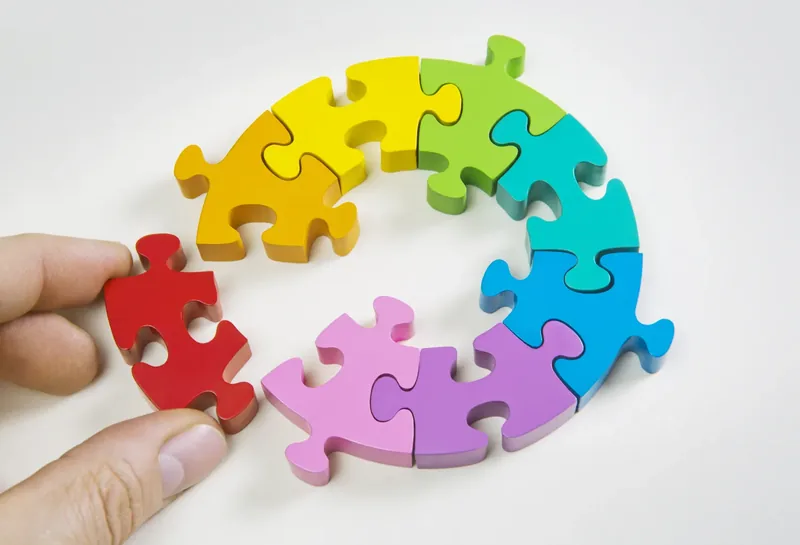Life is a continuous series of challenges, big and small, demanding our attention and ingenuity. From navigating daily dilemmas to tackling significant life decisions, the ability to effectively resolve issues is a cornerstone of personal and professional success. Embracing robust problem-solving strategies finding the right path forward can transform obstacles into opportunities for growth and innovation (Harvard, 2024). This guide delves into a comprehensive, seven-step cycle designed to equip you with the mental tools and actionable steps needed to confront any problem with confidence and clarity.
At its core, problem-solving is a cognitive process that involves identifying, analyzing, and ultimately overcoming barriers to achieve a desired outcome. It's about moving from a current, undesirable state to a more favorable one. While the specific approach may vary based on the situation, a structured framework significantly boosts efficiency and the likelihood of success. By systematically applying these methods, you'll enhance your critical thinking and decision-making capabilities, leading to more sustainable and impactful solutions in every facet of your life.
Table of Contents
- Identifying the Root Cause of a Problem
- Clearly Defining the Problem's Scope
- Developing Effective Solution Strategies
- Organizing Essential Information for Decisions
- Strategically Allocating Resources for Resolution
- Monitoring Progress and Adapting Your Approach
- Evaluating Outcomes and Learning from Experience
- Frequently Asked Questions
1. Identifying the Root Cause of a Problem
The initial stage of any effective problem-solving journey begins with accurately identifying the problem itself. While this might seem straightforward, many attempts at resolution fail because the true underlying issue remains unaddressed. Often, what appears to be the problem is merely a symptom of a deeper, more fundamental challenge. For instance, a small business experiencing a decline in sales might initially blame poor marketing, but after deeper analysis, the real problem could be outdated product features or a shift in consumer preferences in 2025. Misidentifying the problem can lead to wasted resources and persistent frustration, as efforts are directed at superficial fixes rather than core issues.
To effectively pinpoint the problem, it's crucial to adopt a curious and analytical mindset. Start by asking probing questions like "why?" repeatedly (the "5 Whys" technique) to dig beneath the surface and uncover causal relationships. Breaking down a complex problem into smaller, more manageable components can also reveal hidden connections and simplify the diagnostic process. Consider the issue from multiple perspectives – how might a customer, an employee, or a competitor view this situation? Engaging in thorough research, whether through data analysis, interviews, or market studies, helps establish the factual context and identify variables influencing the situation. This comprehensive approach ensures that you're targeting the actual source of the difficulty, setting a solid foundation for all subsequent problem-solving strategies finding a lasting solution.
2. Clearly Defining the Problem's Scope
Once a potential problem has been identified, the next critical step is to define it clearly and comprehensively. This involves outlining every aspect of the challenge and setting precise goals for what constitutes a successful resolution. A well-defined problem statement acts as a roadmap, guiding your efforts and preventing scope creep or misdirected energy. This stage requires a meticulous approach to distinguish between objective facts and subjective opinions or assumptions, ensuring that your definition is grounded in reality. For example, stating "team morale is low" is an opinion, while "employee survey data shows a 30% decrease in satisfaction with internal communication over the last quarter" is a factual, operationally defined problem.
Defining the problem also involves establishing its boundaries and scope. What exactly are you trying to solve, and what is outside the current focus? Setting clear parameters helps conserve resources and prevents the problem-solving process from becoming overwhelming. Formulate specific, measurable, achievable, relevant, and time-bound (SMART) goals for the problem's resolution. For instance, instead of "improve customer service," a better definition might be "reduce average customer wait time by 25% within three months." This clarity is vital for developing targeted problem-solving strategies finding an efficient route to your objectives. A precise definition ensures everyone involved understands the challenge, the desired outcome, and the criteria for success, making the entire process more focused and productive.
3. Developing Effective Solution Strategies
With a well-defined problem in hand, the focus shifts to generating and selecting the most effective solution strategies. This phase typically begins with divergent thinking, where you brainstorm as many potential solutions as possible without immediate judgment. Techniques like mind mapping, free association, or the SCAMPER method (Substitute, Combine, Adapt, Modify, Put to another use, Eliminate, Reverse) can stimulate creativity and uncover a wide range of possibilities. After this initial generation, convergent thinking comes into play, evaluating and narrowing down the options based on their feasibility, potential impact, and resource requirements.
Two common types of problem-solving strategies finding a way forward are heuristics and algorithms. Heuristics are mental shortcuts or rules of thumb, often based on past experiences, that allow for quick decision-making. They are excellent when time is limited or when dealing with familiar problems, such as choosing a restaurant based on a friend's recommendation. However, heuristics can sometimes lead to biases or suboptimal solutions if the current problem deviates significantly from past experiences. Algorithms, on the other hand, are step-by-step procedures guaranteed to produce a correct result if followed precisely. While highly accurate, algorithms can be time-consuming and resource-intensive, making them suitable for situations demanding high precision, like calculating taxes or diagnosing complex technical issues. In 2025, with increasing data availability, hybrid approaches combining the speed of heuristics with data-driven algorithmic checks are becoming more prevalent, offering a balanced approach to complex challenges.
4. Organizing Essential Information for Decisions
Before committing to any solution, it's paramount to thoroughly organize all available information related to the problem. This step involves a meticulous review of what is known, what is unknown, and what additional data might be required. The quality and completeness of your information directly impact the accuracy and effectiveness of your chosen solution. Making decisions based on inadequate or biased information can lead to flawed outcomes, exacerbating the original problem or creating new ones. For example, if you're planning a complex international trip, gathering detailed information on flight schedules, visa requirements, accommodation options, and local customs is crucial to avoid unforeseen complications.
Effective information organization involves several key activities. First, systematically collect all relevant data, which might include surveys, interviews, existing reports, industry benchmarks, or expert opinions. Next, synthesize this information using tools like SWOT analysis (Strengths, Weaknesses, Opportunities, Threats), Ishikawa (fishbone) diagrams to map causes and effects, or simple pros-and-cons lists. Identify any gaps in your knowledge and plan how to acquire that missing data. Understanding the relationships between different pieces of information helps build a holistic view of the problem and its potential solutions. This structured approach to information management is a cornerstone of robust problem-solving strategies finding an informed and well-considered path to resolution.
5. Strategically Allocating Resources for Resolution
Every problem-solving endeavor operates within certain constraints, most notably the availability of resources. This stage involves a pragmatic assessment of what you have at your disposal—time, money, personnel, expertise, and technology—and determining how best to deploy these assets. It's crucial to prioritize the problem based on its urgency and importance. A high-priority issue, such as a cybersecurity breach in a financial institution, warrants a significant allocation of resources, whereas a minor administrative inconvenience might only require a minimal investment. This strategic allocation ensures that critical problems receive the attention they deserve without unnecessarily depleting resources for less impactful issues.
This phase also includes a thorough risk assessment. Before implementing any solution, consider all potential factors that might influence the outcome, including unforeseen challenges or negative side effects. What are the potential downsides of each proposed solution? Are there alternative solutions that offer a better risk-reward profile? For instance, developing a new product feature might require significant R&D investment and carry market adoption risks, while a simpler update could be less costly and faster to implement. By carefully evaluating available resources against the problem's priority and the associated risks, you can make an informed decision about which solution to pursue. This careful consideration of resource deployment is a hallmark of intelligent problem-solving strategies finding sustainable and effective solutions in the real world.
6. Monitoring Progress and Adapting Your Approach
Once a problem-solving strategy has been selected and implemented, the work is far from over. The next crucial step is to actively monitor progress to ensure the chosen solution is yielding the desired results. This involves setting up clear metrics and key performance indicators (KPIs) that allow you to track the effectiveness of your actions. For example, if the problem was low customer satisfaction, you might monitor feedback scores, complaint rates, and repeat business percentages. Consistent monitoring provides invaluable feedback, indicating whether the solution is on track or if adjustments are necessary.
Effective problem-solvers are agile and adaptable. If the initial solution isn't producing the expected outcomes, or if new challenges emerge, they are prepared to reevaluate their approach. This might involve tweaking the existing strategy, exploring alternative solutions, or even returning to earlier steps in the problem-solving cycle to redefine the problem with new insights. In today's dynamic environment, particularly in 2025, continuous feedback loops are essential. For instance, a personal fitness goal requires monitoring diet and exercise, and if progress stalls, adapting the routine or nutritional plan is key. This iterative process, characterized by ongoing observation and a willingness to course-correct, is fundamental to successful problem-solving strategies finding a truly robust and lasting resolution.
7. Evaluating Outcomes and Learning from Experience
The final stage in the problem-solving cycle involves a comprehensive evaluation of the results achieved. This assessment determines whether the problem has been adequately resolved and if the chosen solution was indeed the best possible approach. Evaluation can be immediate, such as verifying the correctness of a mathematical solution, or it can be a long-term process, like assessing the sustained impact of a new organizational policy months after its implementation. The criteria for success should align with the specific goals established during the problem definition phase. Did the solution meet the SMART goals? Was it efficient? Was it sustainable?
Beyond simply confirming success, this evaluation phase is a powerful opportunity for learning and continuous improvement. Documenting the entire problem-solving process—from initial identification to final evaluation—creates a valuable knowledge base for future challenges. What worked well? What didn't, and why? What lessons can be applied to similar situations in the future? For instance, after launching a new marketing campaign, evaluating its ROI, audience engagement, and conversion rates provides critical insights for future campaigns. This reflection not only refines your personal and organizational problem-solving strategies finding more effective methods but also builds a culture of continuous learning, preparing you for the inevitable next set of problems that life and work will present.
Frequently Asked Questions
What are the main steps in problem-solving?
The core steps in effective problem-solving involve identifying and defining the problem, forming a strategy, organizing information, allocating resources, monitoring progress, and evaluating the results. This cyclical process ensures a thorough and adaptable approach to finding solutions.
How can I improve my problem-solving skills?
To enhance your problem-solving skills, practice breaking down complex issues into smaller parts, brainstorm diverse solutions without immediate judgment, and actively seek different perspectives. Learning from every challenge, both successes and failures, is crucial for continuous improvement.
What is a good example of problem-solving?
A good example of problem-solving is a team identifying a consistent drop in customer satisfaction. They define the problem as slow response times, implement new communication protocols, monitor improvements, and evaluate the positive impact on customer feedback scores.
Why is problem-solving important in 2025?
In 2025, with rapid technological advancements and evolving global challenges, strong problem-solving skills are more critical than ever. They enable individuals and organizations to adapt to change, innovate, and navigate complex environments effectively, fostering resilience and growth.




